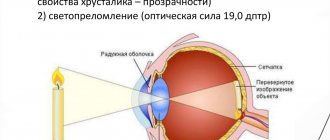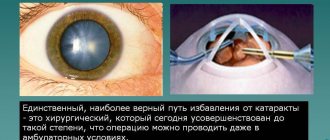What is a cataract?
Cataract is a clouding of the eye lens, which is a natural lens that transmits and refracts light rays.
The lens is located inside the eyeball between the iris and the vitreous body. When a person is young, his lens is transparent, elastic, and capable of changing its shape, instantly focusing on an object. Due to this property, the eye sees equally well at close and far distances.
With cataracts, the transparency of the eye is lost. Due to partial or complete clouding of the lens, only a small part of the light rays enters the eye, as a result of which vision decreases and the person sees unclearly and blurred. Over time, the disease progresses: clouding increases and vision decreases even more. If cataracts are not treated, a person can become completely blind.
Cataracts can begin at any age. The disease can be congenital, traumatic, radiation, caused by general diseases of the body. However, the most common is the so-called age-related (senile) cataract, and this disease develops in people after 50 years of age.
Around 17 million people worldwide suffer from cataracts; for the most part these are people over 60 years of age. According to the World Health Organization, by the age of 70-80, about 260 men and 460 women out of 1000 people suffer from this disease, and after 80 years, almost everyone has cataracts. 20 million people in the world have lost their sight completely due to cataracts.
Cataract surgery
The Excimer Clinic has impressive experience in the surgical treatment of cataracts: more than 150 thousand operations have been performed . The Excimer Clinic has all the modern capabilities: the latest generation microsurgical equipment, unique femtosecond technologies, and highly qualified specialists.
At the Excimer clinic, as in all modern ophthalmological centers and clinics, treatment is carried out using phacoemulsification of cataracts (ultrasound and using a femtosecond laser) with implantation of an artificial intraocular lens. This operation consists of replacing the clouded lens with an artificial one - an intraocular lens - and is recognized by the world ophthalmological community as the most reliable, painless and non-traumatic way to remove cataracts.
Cataract surgery is the only effective way to cure cataracts once and for all and restore full vision.
When is cataract surgery performed?
Delay is dangerous!
Cataract treatment is carried out immediately as soon as vision begins to deteriorate due to it and the person feels discomfort. There is no need to wait for the cataract to “ripen”, and it is often even dangerous for your vision!
Cataracts develop gradually, and from the initial stage (when opacities are observed along the periphery of the lens and do not affect the central zone) several years may pass until the complete loss of transparency. However, as soon as opacities develop in the central visual zone, vision begins to seriously deteriorate. Previously, in order to achieve the best treatment results, it was necessary to wait until the cataract matured, in other words, to become almost completely blind - and therefore to abandon the usual way of life. Now cataracts no longer have to ruin your life.
What will happen if left untreated?
Many people still believe that there is no need to rush into cataract treatment. This opinion is not safe for health! With developed cataracts, in addition to serious visual discomfort, there is a risk of irreversible loss of vision. With cataracts, the lens not only becomes cloudy, but also increases in size, making it difficult for fluid to circulate inside the eye. As a result, intraocular pressure increases, so-called secondary glaucoma develops, which leads to gradual atrophy of the optic nerve. Visual signals stop reaching the brain, and without surgery, vision can be lost forever.
Causes and symptoms of senile cataracts
Cataracts usually develop in older people after age 50. The second name of the pathology is senile disease (the word “senilis” translated from Latin means “senile”). Among the prerequisites for the development of the disease at this age are:
- diabetes;
- myopia;
- infectious diseases;
- prolonged exposure to ultraviolet radiation;
- glaucoma;
- exposure to toxic fumes.
All these factors can act one at a time or several at the same time. They lead to loss of transparency of the lens. The main reason for the development of age-related cataracts is the natural aging process in the body. They are accompanied by the following irreversible processes:
- the formation and accumulation of free radicals that destroy cell membranes;
- an increase in the level of insoluble proteins and, conversely, a decrease in soluble proteins;
- decrease in the concentration of substances such as amino acids, ATP, enzymes;
- changes in the composition of intraocular fluid.
Often patients do not pay attention to a slight deterioration in vision. They consider this a common age-related manifestation, unaware of the course of the latent phase of the disease. The following signs should be the reason for consulting a doctor:
- general deterioration of vision;
- discomfort in the eye area;
- “floaters” before the eyes, bright circles and flashes;
- clouding of the pupil, which is visible from the side with the naked eye;
- blurred outlines of objects;
- development of “night blindness”;
- double vision, blurred lines;
- transition from farsightedness to nearsightedness;
- excessive sensitivity to light, which was not there before.
It is important to establish the stage of development of the disease in order to select the appropriate treatment regimen.
Performing surgery on elderly people
Patients often worry: is it possible to remove cataracts in very elderly people? Of course yes. Age does not affect the decision to remove cataracts. Local drip anesthesia used during phacoemulsification of cataracts eliminates unnecessary stress on the cardiovascular system and the body as a whole and makes it possible to operate on patients of all age groups. Thus, the youngest patient at the Excimer clinic, who had a cataract removed, was only 5 months old, and the oldest was 102 years old. Cataract treatment does not require a hospital stay, which is important for older people: they do not experience the stress associated with hospitalization. Vision returns quickly, and the person does not need any special additional care during the rehabilitation period.
Reasons for appearance
Normally, the lens is completely transparent. It consists of water, proteins and minerals. The lens is nourished by intraocular moisture, which, produced in the eye, constantly washes it. But with age, metabolic products begin to accumulate in this fluid, which have a toxic effect on the lens. This entails disturbances in its nutrition, as a result of which the lens loses its former transparency. The nature of the opacities varies, so the typical variety of cataracts is quite extensive.
In addition to age, the formation of lens opacities is also influenced by some eye diseases, as well as pathologies of other organs. These types of cataracts are called complicated. They develop with glaucoma, myopia, diseases of the choroid, retinal detachments and pigmentary dystrophies.
Indications for surgery
Surgical intervention is performed in the following cases:
- Overripe form of cataract;
- Swelling type of illness;
- Lens luxation;
- Secondary glaucoma;
- Abnormal types of lens opacities.
In addition to medical indications for surgery, there are also professional and household indications. Some activities require clear and sharp vision. For example, drivers or pilots. The doctor recommends IOL implantation if the optical fields are significantly reduced.
Intracapsular extraction
This method of removing the lens differs from the previous one in that the capsule of the clouded part of the eye is also removed. To perform this procedure, a large corneal incision is required, which is its main disadvantage. The lens is frozen to a cryoextractor and removed. An intraocular lens is installed in its place. In this case, sutures are not always applied; their presence depends on the type of artificial lens. Ophthalmologists give recommendations to patients for intracapsular extraction if not only opacification, but also displacement of the lens is detected.
If the cataract is removed using the intracapsular method, the capsular bag in the eye remains. It will ensure the correct positioning of the artificial lens and help avoid a number of complications. The doctor must inform the person that this method of removal is very traumatic. Due to the large incision, the iris of the eye may be deformed, which will negatively affect vision. Intracapsular and extracapsular extraction is carried out only if there are compelling indications.
The gold standard in surgical ophthalmology is ultrasound phacoemulsification of cataracts.
Ultrasonic lens crushing was first used more than 40 years ago. To date, ultrasound phacoemulsification of cataracts is considered the gold standard for treating the disease.
Videos of ultrasound phacoemulsification cataract surgery can be found in the search.
- The preoperative and preparatory stages of this surgical operation correspond to those for extracapsular cataract extraction. For anesthesia, only local (drip) drugs .
- The corneal incision is made minimal - up to 3-3.5 mm. This length is sufficient, since large elements will not have to be removed after crushing.
- a circular hole (capsulorhexis) is made in the anterior capsule of the lens .
- Liquid is injected into the capsule. Hydrodissection is needed to reduce the stability of the lens.
- Next is executed ultrasonic crushing of the lens. Under the influence of waves, the tissue is destroyed - emulsified.
- Small fragments are aspirated through the phacoemulsifier system. The surgeon removes all lens tissue, any residual mass, and epithelial cells from the surface of the posterior capsule.
- After removal of the lens tissue, an intraocular lens is installed in its place .
- The incision is sealed without the use of suture materials.
The advantages of ultrasonic phacoemulsification of cataracts are low morbidity and short duration of the rehabilitation period.
Complications are possible in 1-1.5% of patients. The most dangerous consequences can be hemorrhages and retinal detachment. The cause of such complications is considered to be damage to the structures of the eye by ultrasonic waves. During the intervention, the surgeon tries to minimize the time and intensity of the phacoemulsifier.
Patients with particularly dense lens tissue and retinal angiopathy are not referred for ultrasound treatment. They are mostly recommended for classical intervention - extracapsular cataract extraction.
Symptoms
The name of the disease was given by the ancient Greeks. The word kataraktes means "waterfall".
With cataracts, a person sees “as if in a fog,” as if through foggy glass or through “falling water.” As cataracts develop, the “fogginess” of vision increases, a person feels more and more acutely a veil before the eyes, flickering stripes, spots and streaks. Photophobia appears, images often appear in two, and difficulties arise when reading, writing, sewing, and working with small parts. At the overripe stage of cataract, the color of the pupil becomes white.
Age-related cataracts are a progressive disease that undergoes several stages of development:
- Initial cataract (clouding of the lens occurs on the periphery, that is, outside the optical zone). The patient usually does not make any complaints; the presence of the disease can be determined by an ophthalmologist during an examination. Doctors often discover symptoms of early cataracts by chance during a medical examination.
- Immature cataract (opacity moves into the central optical zone). Visual acuity is noticeably reduced. The patient complains of thick fog before the eyes. The disease leads to difficulties in self-care and performing professional duties. The patient requires surgical treatment.
- Mature cataract (opacities occupy the entire area of the lens). There is a decrease in vision to the level of light perception. The patient sees only the outlines of objects located at arm's length.
- Overripe cataract (the substance of the lens liquefies and it acquires a uniform milky-white hue). The patient can detect the presence of a bright window in the room or the light from a flashlight aimed at the eye. Overripe cataracts can cause numerous complications. The development of secondary glaucoma is especially dangerous due to compression of the surrounding tissues of the eye by an enlarged, clouded lens. The ligaments that hold the lens are also involved in the dystrophic process (an example is macular degeneration of the retina). They can rupture, causing the lens to dislocate into the vitreous. The proteins of an overripe lens are perceived by the tissues of the eye as foreign, and this can cause the development of iridocyclitis.
Read more about vision testing and glasses selection here.
Expert opinion
Pershin Kirill Borisovich
Leading ophthalmic surgeon and medical director of the Excimer clinics, doctor of the highest category, Doctor of Medical Sciences, professor, academician of the Russian Academy of Natural Sciences
The presence of cataracts can be assumed by the characteristic deterioration of vision. At the initial stage, a person suffering from this disease may be bothered by flickering before the eyes: streaks, spots; decreased contrast sensitivity. Difficulties appear when reading. Then, as the cataract develops, visual acuity also decreases: the surrounding world is seen unclearly, as if through a veil of fog, which thickens more and more. However, similar symptoms may be present in other eye diseases; only a specialist can make a diagnosis with 100% accuracy and determine the optimal method of treatment, so it is important to undergo examinations regularly, at least once a year. People of the older generation should pay special attention to the health of their eyes - if we talk about cataracts, the factor contributing to its development is, first of all, age-related changes that occur in the human body. This disease can also be triggered by endocrine disorders, metabolic disorders, eye injuries, exposure to unfavorable environmental conditions, long-term use of certain medications, etc. Taking into account the danger of developing complications, you should not delay getting rid of the disease.
Cataract removal in old age
Manifestations of cataracts are varied, but most often they relate to visual impairment. Like any other disease, it is better to diagnose cataracts in its early stages in order to begin treatment immediately.
To learn about the treatment of iridocyclitis, follow the link.
Treatment methods
Medication
Not many people know about the possibility of treating cataracts. At the initial stage of cataract development, doctors recommend using eye drops:
- Quinax;
- Vita-Iodurol;
- Taufon;
- Oftan-Katachrome.
These drugs prevent the progression of opacities, but are not able to resolve existing ones. They can also be used in the treatment of retinal detachment. It should be remembered: only an ophthalmologist prescribes drugs and the method of their use.
Healthy and diseased eye
Surgical
The main method of getting rid of cataracts is surgery . This cataract surgery is called phacoemulsification with implantation of an artificial posterior chamber intraocular lens. Those. They replace the lens of the eye for cataracts. This operation is performed in 99% of patient cases. The most favorable outcome of surgical treatment can be observed in patients with immature cataracts.
Read about the surgical treatment of strabismus in children.
The phacoemulsification method has been used in Russia for about 20 years.
The operation is performed under local anesthesia. The flow of the operation is as follows:
- An ultrasonic tip 2.2 m long is inserted into the eye through a corneal incision, which destroys the cloudy lens.
- An artificial flexible lens is implanted into the lens capsule.
The operation usually lasts no more than 20 minutes. Vision is restored within the first day to preoperative levels. During the recovery period, which is about 4 weeks, the patient must be injected into the eyes with drops that have an anti-inflammatory effect. After a month, you can return to your normal lifestyle.
If the patient has mature or overmature cataracts, complicated by weakness of the ligaments supporting the lens, intra- or extracapsular cataract extraction is performed. The essence of the operation is to remove the entire lens. Instead, a rigid lens is implanted, which is sutured to the iris or attached to the lens capsule. In this case, a continuous suture is required, which can be removed only after 4–6 months. In the first months after surgery, the patient's vision is poor due to postoperative reverse astigmatism. But after removal of the suture, the level of vision becomes the same as the patient had before the formation of cataracts. The rehabilitation period is dangerous due to dehiscence of the postoperative wound.
Possible complications
After removing the cloudy lens, the human eye is deprived of a very important optical part - the lens. The refractive properties of the vitreous body, cornea and anterior chamber moisture are not enough for good vision. The operated eye requires a vision test and selection of glasses, contact lenses or an artificial lens. You can read about glasses that protect against computer radiation.
How does a sick person see?
The most optimal way to treat cataracts is implantation of an artificial lens. However, it is not always possible to apply it. The condition of the patient's eye tissue or blood vessels, as well as some of his diseases (frequent exacerbations of the joints, recurrent inflammation of the eyes) do not allow the implantation of an artificial lens, since they will minimize the results of the operation.
Cataract treatment
At an advanced stage of cataract (mature and overmature), the swollen lens occupies most of the anterior chamber of the eye, as a result of which it disrupts the outflow of intraocular fluid. As a result, a dangerous complication of cataracts can occur - secondary glaucoma. If surgery is not performed immediately, vision may be permanently lost.
Cataract treatment should not be delayed.
Laser cataract surgery - indications for laser phacoemulsification
Laser phacoemulsification for crushing the lens involves exposure to a fixed wavelength beam from a laser ophthalmic device .
- After micro-incision of the cornea and capsulorhexis, elements of the fiber-optic system are introduced into the anterior chamber
- The laser beam destroys the lens tissue.
- The masses are discharged in the form of an emulsion through a system of tubes.
- Next, the surface of the posterior capsule is “polished” and an intraocular lens is installed.
- The incision is sealed without the use of sutures.
Drug treatment of age-related cataracts
Only an experienced ophthalmologist can diagnose and treat eye cataracts. Before starting pathology therapy, a number of diagnostic studies are carried out, with the help of which the stage and characteristics of the course of the disease are determined. If the initial stage of the pathology has been diagnosed, then drug therapy is prescribed, including the following drugs for cataracts:
- means that normalize metabolic processes: Fakovit;
- ascorbic acid;
- vitamin-mineral complexes, dietary supplements;
- eye drops: Taufon, Quinax, Vitafacol and others.
Read in a separate article: Treatment and removal of eye cataracts with laser - features and recommendations
The basis of conservative treatment of cataracts in the elderly is the use of various eye drops. It is not possible to cure cataracts using a conservative method, but medications for cataracts improve nutrition, stabilize IOP and slow down the pathological process.
It is not possible to cure the disease using a conservative method, but medications for cataracts improve nutrition, stabilize IOP and slow down the pathological process.
Recovery after cataract surgery
Phacoemulsification does not require long postoperative recovery. Sensitivity to the operated eye returns 3-4 hours after completion of surgical procedures. You can watch TV and read books on the same day on which the lens was replaced.
After surgery, it is recommended to avoid:
- physical activity;
- getting shampoo, soap and other detergents into the eyes;
- use of makeup (in the next 5 days inclusive);
- any other effects on the eyeball.
At the discretion of the attending physician, the patient may be prescribed antibacterial and anti-inflammatory drops. The type of medication is determined individually, and medications are prescribed in case of postoperative complications.
Prevention
The main way to prevent cataracts is a timely visit to an ophthalmologist. People over 40 years of age need to undergo an examination in an eye office once a year to identify changes in the lens. Remember: only a specialist can determine the need for drug or surgical treatment. Do not try to cope with the problem yourself using unconventional methods or folk remedies. Lost time is the main cause of irreversible blindness.
Drops have already been created and are widely used that can slow down the process of cataract maturation. These drops, called vitamin drops, contain amino acids, enzymes and trace elements.
Their systematic use improves nutrition and metabolic processes in the lens, thereby inhibiting the development of cataracts. However, it is impossible to stop the process of clouding that has begun with the help of drops; you can only slow down the disease. Only an ophthalmologist will help you decide on the choice and dosage of drops, who will give the necessary recommendations taking into account the nature of the opacities and the reasons that caused the onset of cataract formation.
Dacryocystitis in adults. Read how to restore your vision at home here.
Discomfort when wearing lenses: https://eyesdocs.ru/linzy/uxod/kak-izbezhat-diskomforta-pri-noshenii-kontaktnyx-linz.html
Reasons for development
Most cataracts are an acquired disease. In the world, there are only 3% of patients with congenital pathology of this kind, which occurs in utero due to diseases suffered by the mother during pregnancy or her chronic ailments. Prerequisites for the appearance of cataracts in a newborn may be:
- rubella;
- toxoplasmosis;
- diabetes;
- calcium deficiency;
- hypothyroidism
You may be interested in: I can’t see well up close – what should I do? What is vision called when you can't see well up close?
In children, the disease usually does not progress unless it is combined with other serious illnesses, and vision drops to 0.3 and remains so for a long period. In some cases, infants are indicated for cataract surgery, but this decision is made by the doctor together with the baby’s parents.
Acquired lens opacification develops at a fairly mature age and progresses rapidly. About 90% of pathologies are associated with aging of the entire body, and 10% occur due to external factors such as injury or radiation.
The most common causes of cataracts in adults are:
- ultraviolet or radiation radiation;
- age;
- injuries affecting the lens;
- infectious diseases;
- autoimmune pathologies;
- thyroid problems;
- ophthalmic comorbidities;
- operations on the eyeball;
- long-term treatment with corticosteroids;
- influence of toxic substances.
Indications for the procedure
The surgical method, which allows you to restore vision, is recommended in the following cases:
- For cataracts. The pathological disorder is usually observed in older people. Because of this, they cannot clearly see objects around them.
- With age-related changes. The procedure is recommended for patients diagnosed with presbyopia and solves the problem of farsightedness.
- For astigmatism. The disease disrupts the shape and curvature of the visual organ, which significantly reduces its ability to focus on a specific object.
- For myopia. The method, through which part of the visual organ is replaced, is an alternative to glasses and lenses, which cause a lot of inconvenience when worn.
If a person with poor vision has an objective indication for a surgical procedure, during an examination in the doctor's office he will be offered to replace the lens of the eye using ultrasound phacoemulsification.
Current issues
Ë
È
Can cataracts develop again?
There are cases that some time after ultrasound phacoemulsification with implantation of an artificial intraocular lens, the patient is diagnosed with secondary cataracts (clouding of the posterior capsule of the lens). Secondary cataracts are not an indication that the operation was performed poorly. Cloudiness may appear in the early or late postoperative period (sometimes several years after the operation) . In this case, there is a decrease in vision, “fog” before the eyes, because Secondary cataracts can impair vision in much the same way as primary cataracts. Most often, patients with diseases such as glaucoma, high myopia, uveitis, diabetes, and systemic diseases are at risk for secondary cataracts. In the case of secondary cataracts, laser treatment is performed, and in most cases repeated surgery is not required.
Ë
È
How has the laser machine used to remove cataracts proven itself? Are there any numbers?
Over 300 thousand operations have been successfully performed using the LenSx surgical femtosecond laser system from Alcon (USA). More than 550 systems have been installed in 50 countries. These figures indicate that the use of laser technology in cataract surgery has confidently proven itself and has become in demand around the world.
Ë
È
How to understand your prices in the price list for cataract treatment? What determines the cost of the operation?
The cost of cataract surgery depends on the choice of lens, the degree of development of the disease, and the presence of concomitant diseases. The cost of the operation is indicated for one eye and includes both the operation itself and the cost of the lens, consumables, as well as postoperative examinations.
| Ask a Question | All questions |
conclusions
So, senile cataracts, even in very old age, can be successfully treated. It is important not to advance the disease to a mature or overripe stage, so that it is not complicated by accompanying inflammation. Well-proven surgical technique, a variety of artificial lens models, competent anesthesia - all this makes this operation minimally dangerous. Today, such operations are carried out at a high level and give successful results, including relieving the consequences of destruction of the vitreous body of the eye. The main thing is to detect cataracts in time and not delay its treatment.
The best way to avoid disease is to prevent it. Therefore, you should not trigger certain factors that precede this, such as mucopurulent conjunctivitis.
Choosing an IOL for Cataract Treatment
When the lens is completely removed, the patient, together with the surgeon, selects intraocular artificial lenses that will perform the function of natural analogues. There are several types of IOLs, each of which has its own characteristics:
- Monoblock. They allow for quick recovery after surgery and require a microscopic incision of the cornea.
- Aspherical. Indicated for complex pathologies. Their advantage is their ability to reduce glare in the twilight.
- Toric. They are used to correct astigmatism and disruption of the corneal layer.
- Multifocal. They have the ability to form several foci on the retina, which allows them to clearly see objects at different distances.
Artificial IOLs are 100% biocompatible with human body tissues. This means that the body will not perceive them as a foreign element and will not begin the process of rejection. After implantation of an artificial lens, the patient does not feel discomfort in the visual organ, he can freely move the eyeballs in any direction.
Replacing the lens of the eye. What to expect before and on the day of surgery
Before lens replacement surgery, you must undergo a full examination and consultation with an ophthalmologist. During the consultation, an anamnesis will be collected, and concomitant eye diseases will be diagnosed. You will also be explained how and in what dosages you need to take medications prescribed by other specialists, for example, for diabetes. An important step before surgery is to calculate the optical power of the artificial lens that will be installed after the cataract removal is completed.
It is important to remember and strictly follow the doctor’s instructions, for example regarding meals, which should take place no later than 2 hours before arriving at the clinic. Since cataract surgery is performed in an outpatient clinic, it is necessary to have an accompanying person from among relatives or friends. The time spent in the eye microsurgery clinic of Svyatoslav Fedorov before and after lens replacement surgery averages three hours
During cataract removal, several members of the medical team are present in the operating room, including: a surgeon, an anesthesiologist, and operating room nurses. The actual time that cataract surgery takes is 20 minutes. During the operation, you will feel touch and there will be no pain. After your cataract surgery is complete, you will spend about half an hour in the recovery room.
Cataract surgery. Progress of cataract phacoemulsification surgery:
- Two tiny incisions of the fibrous membrane of the cornea (in the form of a tunnel, equal in length and width), size 2.0 and 1.0 millimeters.
- Circular dissection of the anterior wall of the capsular bag
- A small surgical ultrasound probe fragments and softens the lens
- Removal of fragments and soft masses using vacuum from the capsular bag
- Polishing the walls of the capsular bag at low threshold values of vacuum and aspiration
- Installation of an artificial lens inside the capsular bag (rotation and alignment of its optical part depending on the type of lens)
- Sealing incisions by creating edema in the thickness of the cornea
Review of cataract treatment at the Excimer Clinic
S. Albina Antonovna, Moscow
I would like to thank doctor Ekaterina Evgenievna and wish her more good patients and all the best. Nowadays you rarely meet a person and a doctor like her. My father had cataracts for a long time, but everyone dissuaded him from surgery because there would be complications and his vision would still decline due to old age!!
Ekaterina Evgenievna was the first to tell us that cataracts should be operated on without waiting for them to mature. She explained everything very clearly and dad himself realized that IT’S TIME!!! Our whole family was preparing for a long rehabilitation, but after the operation, within a few days, he said that he could see perfectly. At the same time, there is no need to stay in the hospital; they were allowed to go home the same day. Then they came to the appointment three times, and thank God, everything was fine!!!!!!!!!!! Thank you for giving older people the opportunity to see and be independent, this is truly very important for them. Thank you very much!!!!!!!!!!!!!!!!
R. Victoria Ivanovna, Moscow
I was looking for a doctor for my mother for a long time, and finally found one. Ekaterina Antonovna, thank you very much for not leaving us in a difficult situation, many doctors simply abandoned us, I had already given up all hope. Mom had cataracts, we were observed by Ekaterina Antonovna for three months, now I can’t even imagine what we would have done if it weren’t for her. We had an operation, and now a new life has just begun!!! Already at the dacha and walking with his grandchildren. I couldn’t even imagine that everything could be done so easily, I thought that I would have to sit at home with her for several months. Thanks again to all the doctors of the clinic, you are doing a good job!!!!
D. Larisa, Moscow
Dear Excimer Clinic! I want to convey the best, most sincere and warm words of gratitude to the wonderful doctor, a professional with a capital P and a wonderful person, Kirill Borisovich Pershin! With the return of vision after the operation performed on my mother, Dvoretskaya Zoya Alexandrovna, joy and happiness came into our home, a happiness that had been lost several years ago. But the most important thing is that with the return of vision, life, activity, the joy of learning about the world and activity returned to my mother in the literal sense! Mom enjoys life again and is full of energy! In the very near future we will perform surgery on the second eye. And we convey a low bow to Kirill Borisovich, words of gratitude and wish him great health, great happiness and outstanding success in his miraculous work! Thank you, Kirill Borisovich!!!
All reviews on the topic
Diagnosis of cataracts
The developing disease can be noticed immediately. The lens takes on a light cloudy tint. At the beginning of the development of the disease, the disease can be diagnosed using ophthalmological instruments.
If the development of cataracts is not too advanced, a specialist can conduct an examination using a slit lamp , which is used to examine the eye. To dilate the pupil, they resort to medication in the form of drops. The direction of the lamp rays makes it possible to make an optical incision through the eyeball.
The disease can be diagnosed using a slit lamp
This method allows you to accurately assess the location and severity of changes in the ocular structure. Patients who received drops upon completion of the examination are prohibited from driving a car for several hours.
Also, specialists are required to conduct endothelial microscopy of the corneas , which is necessary in order to determine by what method the lens will be removed.
Corneal endothelial microscopy
Should I have surgery?
Cataract is a complex disease leading to unpleasant consequences. If left untreated, the person is guaranteed blindness in the future. However, the decision to undergo surgery is not easy for many. Experts say that you should definitely undergo a comprehensive study. And if the results alarm you, you need to contact another specialist. Perhaps you will be convinced of the correctness of the diagnosis and the need for surgery in the first minutes of your visit, or the doctor will suggest an alternative method of therapy.
In any case, seeing a doctor is the first step towards treatment. Modern medical equipment makes it possible to identify the problem and deal with it in the early stages.
If all the doctors you consulted diagnosed cataracts, then you should immediately begin treatment or prepare for surgery. Listen to the opinion of the ophthalmologist and find out what way out of this situation he suggests.
The patient should keep in mind that lens clouding is an irreversible process that requires medical intervention. The consequences of the development of the disease are not only the loss of transparency of the vitreous body, but also its increase in size, which complicates the outflow of intraocular fluid. This leads to increased blood pressure and the development of glaucoma.
How to behave after lens replacement?
Any surgical intervention requires a subsequent rehabilitation period. What should not be done after cataract surgery, and what manipulations should be performed, we will consider further. The recommendations doctors give to patients are as follows:











